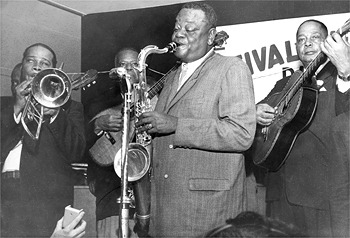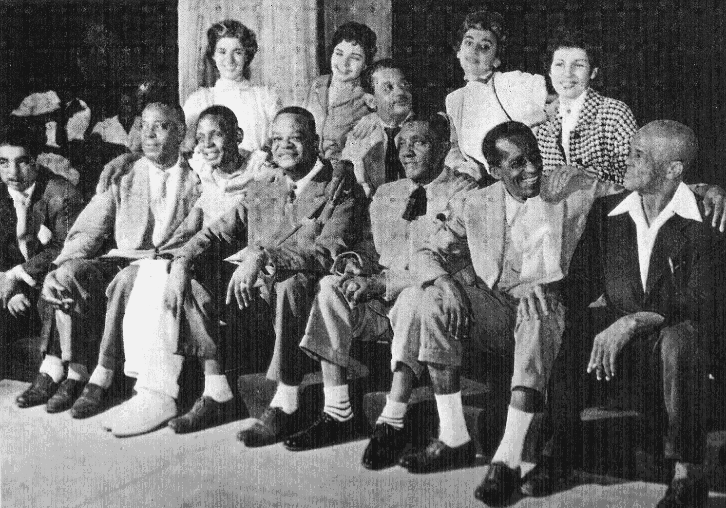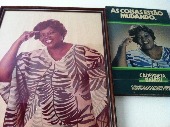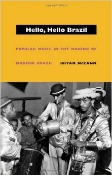The samba carioca developed out of a cauldron of influences mostly blending African and European traits in various combinations in the melting pot City of Rio de Janeiro in the early years of the 20th Century. Tia Ciata’s house was a focal point. There, such samba pioneers as Pixinguinha (Alfredo da Rocha Vianna, Jr., 1898-1973), Donga (Ernesto Joaquim Maria dos Santos, 1891-1974), João da Baiana (João Machado Guedes, 1887-1974), Heitor dos Prazeres (1898-1966), and Sinhô (José Barbosa da Silva, 1888-1930) adapted the Afro-Brazilian lundu, the maxixe (a popular Brazilian dance that fused the lundu with the European polka and Cuban habanera), and the marcha (march), a popular local Carnaval style, among other influences, to forge the earliest incarnation of samba in Rio. The early samba was based to a large extent on the maxixe.
Watch
Donga — "Pelo Telefone"
An extraordinary clip (evidently from 1966) showing Donga as an elder singing the first song registered as a samba (which he had co-composed back in 1916) and executing an elegant samba dance, offering the viewer a taste for what the samba must have been like in its formative years in Rio.
Martinho da Vila, Nelson Sargento, Diogo Nogueira
— "Pelo Telefone"
A contemporary rendition of this samba classic performed by three highly influential samba composers and performers.
Pixinguinha e a Velha Guarda do Samba — "Patrão, Prenda seu Gado" (João da Baiana/Pixinguinha /Donga) A beautiful samba composed by some early samba pioneers in Rio that harkens back to the genre’s roots in Bahia. The film is evidently from the 1950s.
Look


source
Pixinguinha on tenor saxophone. Donga on guitar (rear).
source
Vocalists Elizeth Cardoso and Clementina de Jesus, Composer Angenor de Oliveira ("Cartola"), tenor saxophonist Pixinguinha.

source
(with J. Cascata, Donga, Ataulfo Alves, Pixinguinha, João da Baiana e
Alfredinho).

source
Clementina de Jesus, Pixinguinha and João da Baiana.
Listen
Mario Reis — "Jura"
A famous song composed by the so-called “King of the Samba” in the 1920s, Sinhô, and interpreted by one of the most popular singers of the era, Mario Reis. The instrumental accompaniment is based on the maxixe rhythm.
Read

Rio Journal: Dona Ivone Lara, Samba Legend

Hello, Hello Brazil: Popular Music in the Making of Modern Brazil
An illuminating look at the role of samba in the project of creating a national Brazilian identity.

Samba
A riveting account of the author’s experience living in the Mangueira favela (shantytown slum) and parading with the Mangueira Samba School in the late 1980s. Includes a chapter on samba’s early history in Rio.

The Brazilian Sound
One of the most comprehensive books on Brazilian popular music in English with an excellent chapter on samba.

The Mystery of Samba
A fascinating exploration of how the samba came to be Brazil’s national music.
Learn More
For Lifelong Learners
DISCUSSION Ideas
Discuss
• Listen to the Radio Focus audio clip above, paying close attention to the segment that describes the connection between Candomblé and samba. Then watch the Candomblé segment (beginning at 30:24 and ending at 35:00) in The Spirit of Samba video above. Talk about what you hear and see that connects Candomblé and samba. What are some other musical traditions that connect to religious practices?
For Students
Teaching Ideas
Discuss
• Have students listen to the Radio Focus audio clip above, paying close attention to the segment that describes the connection between Candomblé and samba. Then watch the Candomblé segment (beginning at 30:24 and ending at 35:00) in The Spirit of Samba video above. Have a discussion about what students hear and see that connects Candomblé and samba. What are some other musical traditions that connect to religious practices? [Addresses CCSS Speaking and Listening Standard 4.]
Discover
• Invite students to investigate the Watch, Look and Listen media resources above. Ask students to contribute their ideas about what it means to be a musical pioneer and exchange ideas about who are the pioneers of the music they like to listen to. Then, ask students to conduct research to support their ideas and opinions.
Share
• Students can use this Resource Page as a model for creating a collection of resources that exhibits the accomplishments of their chosen pioneers. Their pages should include a short introductory essay and links to digital content that supports their choices. [Addresses CCSS Reading Standards 1, 3 and 7; Writing Standards 1, 2, and 9; and Speaking and Listening Standards 1, 2, 4 and 5.]